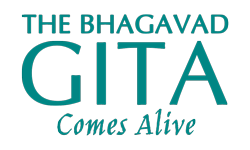Foreword

Foreword by Nilesh Nilkanth Oak
I met Jeffrey Armstrong in Jabalpur, at the World Ramayana Conference in the winter of 2016. We became instant friends, and since then we have been in regular communication. Both he and Prof. Bal Ram Singh were originally the only two scholars who understood the true impact of my dating of the Mahabharata War. Although we hardly knew each other, Jeffrey was the first to express, in no uncertain terms, the importance of my research and why it mattered to his own work as a Vedic scholar and an Ayurvedic astrologer. He went on to explain why the comprehension of ancient Indian astronomy and the accurate historical dating of the Mahabharata (5561 BCE) is crucial for both Gita study and Vedic astrology.
Though we who study and research the Mahabharata and the Bhagavad Gita do not consider ourselves experts in all aspects of the Gita, I am frequently asked which English translation of the Bhagavad Gita I would recommend. Those who ask me always sense my hesitation to answer. I do not hesitate because I have not read them all. Rather, my hesitation is because the many I have read, have all left me dissatisfied.
Against this background, if someone would have told me that they were publishing a new English translation of the Bhagavad Gita, I would have been more irritated than elated. I did not know that Jeffrey had been working on his Bhagavad Gita translation project for more than a decade. He explained the scope and his rationale. I cannot explain why, but I was elated. My early elation turned into conviction that he was on the verge of solving my problem of which translation to recommend.
But the analyst in me needed some proof. So, I asked Jeffrey for his translation of a few specific verses–the verses that test the translator’s adhyatmic (spiritual) acumen. In my assessment, Jeffrey passed with flying colors. Next, I requested he send me his complete translation, and I can assert than I have read no better English translation of the Bhagavad Gita.
The Mahabharata is the composition of the unparalleled genius of Krishna Dvaipayana Vyasa as he documented the itihasa (history) of the Kuru dynasty. The Bhagavad Gita is the pinnacle of Vyasa’s adhyatmic (spiritual) teachings in which he has encoded the wisdom of Bhagavan’s discussion with Arjuna in poetic verse. Whenever I refer to the Bhagavad Gita, I go to the original Sanskrit text, along with a very poetic translation into Marathi by the Acharya Vinoba Bhave. In the future, I will include Jeffrey’s translation, The Bhagavad Gita Comes Alive, as a valuable part of my core Gita studies.
Jeffrey’s translation focuses on conveying the essential, innate and root meaning of each verse of the Bhagavad Gita. He has taken the utmost care in his translation and has decided to keep many of the original Sanskrit words within the English verse where he felt that an English equivalent would only distort the Sanskrit meaning or do more harm. Where necessary, he has inserted short English definitions within the verse, but for non-translatable or deeply nuanced words, he has provided in-depth definitions in a glossary, instead of lengthy purports.
Finally, and most important to this revolutionary translation, he has removed all the misleading, irrelevant and toxic English words that have twisted and distorted all other translations. He has identified, corrected and removed all the colonial and distorting terms which were intentionally used to diminish and subvert the liberating truths of the Gita.
The wisdom of the Bhagavad Gita has impressed oriental and occidental thought leaders alike. Many of them were not aware of the antiquity of this deep wisdom. My curiosity to validate impossible sounding astronomical descriptions of two celestial objects from the Mahabharata led me to extract 300+ astronomical references from the grandest epic of humanity, which in turn determined 5561 BCE as the year of the Mahabharata War and 16 October 5561 BCE (Julian calendar reference) as the day of Gita Jayanti, the birth of the Bhagavad Gita.
Sage Yaskacharya defines Sanatana Vedic Dharma as ‘Sanatano Nityanutana’ (सनातनो नित्यनूतन: - यास्काचार्य) a dharma that is capable of, and insists on, refreshing itself in the light of changing circumstances, time and place. This is the reason various acharyas wrote commentaries on the Bhagavad Gita, apt for the circumstances they envisioned. Jeffrey Armstrong’s translation is in this very spirit and tradition.
It is my wish and desire to see Jeffrey’s radical new translation, The Bhagavad Gita Comes Alive, on the bookshelf of every student of the Gita. We are all students of the Bhagavad Gita.
Nilesh Nilkanth Oak
16 October 2020
Author, When did the Mahabharata War Happen?
Prof Nilesh N Oak, Adjunct Faculty, Institute of Advanced Sciences, Dartmouth, MA holds BS & MS in Chemical Engineering as well as an Executive MBA. Best Selling author of "Rama Ravana Yudh - 12209 BCE"
